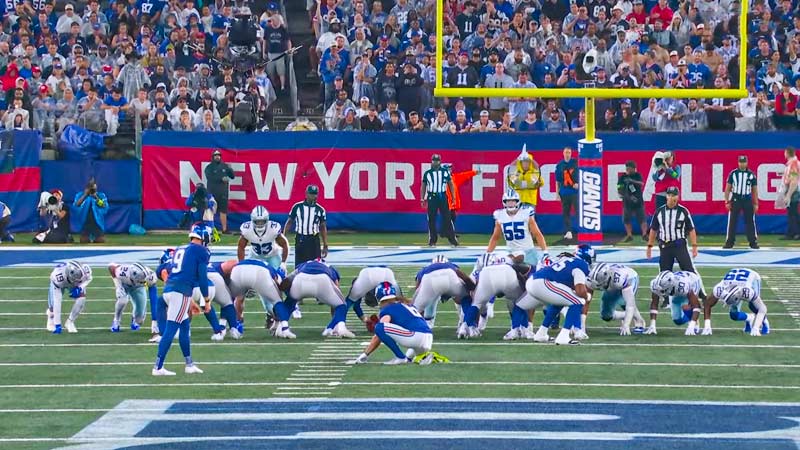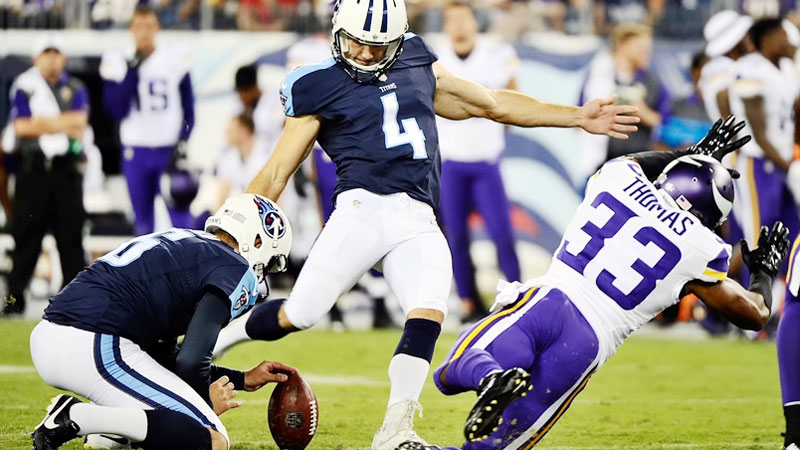Diving into the intricate world of American football, understanding the nuances of extra-point rules is essential for fans and newcomers alike.
This comprehensive guide unravels the strategies and dynamics behind the traditional extra-point and two-point conversion.
From the kicker’s precision to defensive scoring opportunities, we explore the less-known facets that shape these critical moments in the game.
Discover how penalties can sway the outcome and why weather conditions are pivotal in decision-making.
Whether you’re a seasoned football enthusiast or a curious newcomer, this exploration of American football’s extra-point rules will deepen your appreciation for the strategic intricacies woven into every touchdown celebration. So, stay focused.
The Basics of Extra Points in American Football
In American football, extra points are attempts to score additional points after a touchdown.
After a team scores a touchdown by advancing the ball into the opponent’s end zone, they can kick an extra point or attempt a two-point conversion.
The traditional extra point involves a kicker attempting to kick the ball through the goalposts from a set distance, typically 33 yards in professional football. A successful kick earns the team one extra point.
Scoring After Touchdowns
Extra points in American football are attempts to score additional points following a touchdown.
Two Options
Teams have two main options for extra points: the traditional kick or the two-point conversion.
Traditional Kick
It involves a kicker attempting to kick the ball through the goalposts from a set distance, typically 33 yards in professional football, earning one point on success.
Two-Point Conversion
Teams can opt for a more challenging two-point conversion, attempting to score by running or passing the ball into the end zone from the opponent’s two-yard line.
Strategic Decision
Coaches decide between the safer traditional kick and the riskier two-point conversion based on the game situation, team strengths, and the desire to maximize points.
Weather Impact
Adverse weather conditions can affect the success rate of kicks, adding an element of unpredictability to the decision-making process.
Alternatively, a team can opt for a two-point conversion by running or passing the ball into the end zone from the opponent’s two-yard line.
Teams strategize between the traditional kick for a safer point or the riskier but more rewarding two-point conversion.
The Traditional Extra Point
In American football, the traditional extra point is a crucial element following a touchdown, offering teams a strategic choice for additional points.
Kicking Distance
The traditional extra point involves a designated kicker attempting to kick the ball through the goalposts from a set distance, typically 33 yards in professional football.
Scoring Impact
Successfully executing the kick adds one point to the team’s overall score, contributing to their lead after a touchdown.
Routine Procedure
Despite its routine nature, the traditional extra point is not a guaranteed success, as kickers must contend with defensive efforts to block the kick.
Strategic Decision
Coaches often weigh the reliability of their kicker against the risk and reward of attempting a two-point conversion, making the traditional extra point a strategic element in game planning.
Game-Changing Moments
While seemingly routine, missed extra points or successful defensive plays against them can significantly impact the outcome of a game, emphasizing the importance of this seemingly routine play.
American Football Extra Point Rules
The extra point rules in American football add an intriguing layer to the game, encompassing lesser-known aspects that can influence outcomes.
Blocked Kicks

Defensive teams can disrupt the traditional extra point by blocking the kicker’s attempt, a rare but exhilarating feat that prevents the scoring of the extra point.
Two-Point Interception or Fumble Return
In the case of a two-point conversion attempt, if the defensive team intercepts the ball or recovers a fumble, they can return it to their end zone for two points, turning a potential offensive gain into a defensive score.
Defensive Scores on Extra Points
On either extra point attempt, if the defence manages to score, whether through a blocked kick or a turnover return, it results in an uncommon but impactful defensive contribution.
Penalty Implications
Penalties during the extra point attempt can alter the scoring situation.
For instance, if the defence commits a penalty, the offence might opt to retry from a shorter distance, potentially influencing their decision between a traditional kick and a two-point conversion.
Weather Factors
Adverse weather conditions, such as strong winds or heavy rain, can significantly affect the success rate of extra point attempts, adding an unpredictable element that teams must consider when making strategic decisions.
The Two-Point Conversion in Football Extra Point
In football’s extra point dynamics, the two-point conversion is a unique and strategic alternative, introducing several less commonly known aspects to the game.
Yardage Variability
Unlike the fixed distance of the traditional extra-point kick, the two-point conversion is attempted from the opponent’s two-yard line, necessitating offensive prowess and precision in a confined space.
Quarterback Sneak
Teams often employ unexpected tactics like the quarterback sneak, where the quarterback carries the ball across the goal line without a formal passing or running play, catching the defence off guard.
Defensive Scoring Opportunity
Suppose the defensive team intercepts the ball, recovers a fumble during a two-point conversion attempt, and returns it to the opponent’s end zone. In that case, they can score two points, transforming a defensive play into a potential game-changing moment.
Fake Kicks and Trick Plays
The two-point conversion allows for creativity in play-calling, with teams occasionally opting for fake kicks, unconventional formations, or trick plays to deceive the defence and secure the additional two points.
Strategic Timing
Coaches strategically decide when to attempt a two-point conversion based on the game situation, score differentials, and overall team performance, making it a calculated choice that can sway the momentum of a match.
Penalties for Breaking Football Extra Point Rules
In football, adherence to extra point rules is crucial, and penalties for infractions can have significant consequences.
Here are some less commonly known penalties associated with breaking extra point rules:
Encroachment
Similar to offside, but on the defensive side, encroachment occurs if a defender crosses the line of scrimmage and makes contact with an offensive player before the snap on an extra-point attempt.
This penalty can result in a shorter distance for the extra point attempt.
Holding
Offensive players must avoid holding or restraining defensive players during the extra point attempt.
A holding penalty can negate a successful kick or conversion and result in a reattempt from a longer distance.
Offensive Pass Interference
If an offensive player commits pass interference during an extra point attempt, it results in a penalty. This penalty can push the offensive team back, making the subsequent effort more challenging.
Defensive Pass Interference
Conversely, defensive pass interference during an extra-point attempt grants the offensive team a penalty advantage, potentially allowing them to retry from a closer distance.
Delay of Game
A delay of game penalty can be incurred if a team takes too much time to initiate the extra point attempt.
This penalty typically results in the ball being moved back, increasing the difficulty of the kick or conversion.
Illegal Formation
Extra point attempts must adhere to specific rules regarding player positioning. An illegal formation penalty may be assessed if the offense or defense does not align properly, impacting the outcome or forcing a retry.
Unsportsmanlike Conduct
Behaviours such as excessive celebration or taunting during an extra point attempt can result in unsportsmanlike conduct penalties. These penalties may impact the team’s positioning or affect subsequent plays.
FAQs
What’s the difference between a traditional extra point and a two-point conversion in American football?
The traditional extra point involves a kick from a set distance after a touchdown, earning one point.
In contrast, a two-point conversion allows the offence to attempt a play from the opponent’s two-yard line, aiming to score two points.
Can a defensive team score during an extra-point attempt?
Yes, if the defense intercepts the ball or recovers a fumble during a two-point conversion and returns it to the opponent’s end zone, they score two points.
It adds an unexpected defensive scoring dynamic to extra-point situations.
What penalties can affect the outcome of an extra-point attempt?
Penalties such as offensive or defensive pass interference, delay of game, illegal formation, or unsportsmanlike conduct can impact extra point attempts.
These penalties may alter the distance of the attempt or influence subsequent plays.
How do weather conditions affect extra-point attempts?
Adverse weather, like strong winds or heavy rain, can significantly impact the success of extra-point attempts, adding an unpredictable element.
Kickers must adjust their strategy based on weather conditions, deciding between a kick and a two-point conversion more critical.
Can a team retry an extra point attempt after a penalty?
Yes, depending on the nature of the penalty. Penalties like defensive pass interference may grant the offensive team another attempt from a closer distance.
However, penalties like the delay of the game can move the team back, making the retry more challenging.
Wrapping Up
In American football, extra-point plays are more than routine scoring—they are pivotal moments that can alter the course of a game.
Each decision carries weight, from the precision of traditional kicks to the strategic complexity of two-point conversions.
Penalties and weather conditions add layers of unpredictability, turning routine plays into game-changers. As the playbook unfolds, understanding these nuances enhances our appreciation for the intricacies of the sport.
Whether a fan cheering from the stands or a strategist analyzing each move, the journey through American football’s extra point rules unveils a dynamic dance between offense, defense, and the unpredictable elements.
They make every touchdown celebration a unique spectacle in the grand theatre of the game. Thank you so much.







